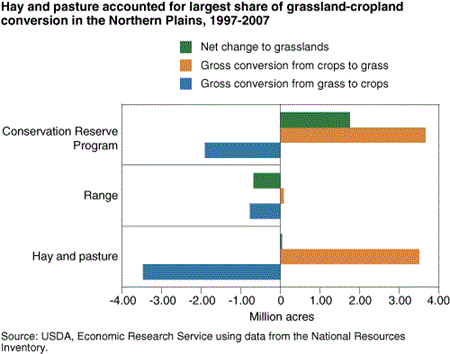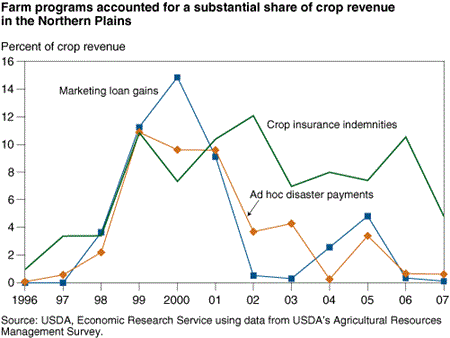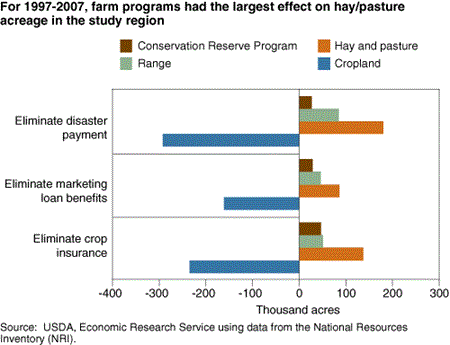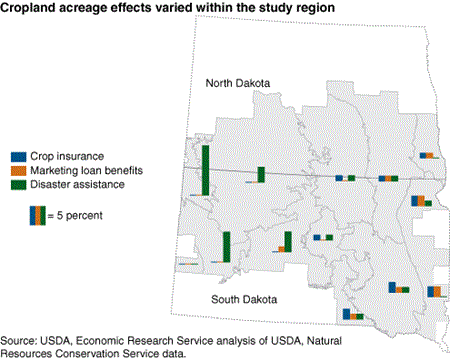Do Farm Programs Encourage Native Grassland Losses?
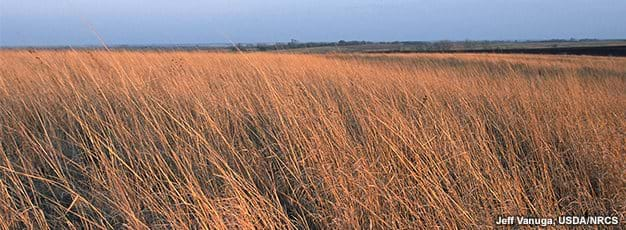
Highlights:
-
In the Northern Plains, a number of migratory birds use native grasslands--land that has never been cultivated for crop production--as breeding habitat. Once cultivated, native grassland habitat is difficult to restore.
-
About 1 percent of Northern Plains rangeland was converted to cropland between 1997 and 2007.
-
Crop insurance, marketing loan benefits, and disaster assistance can encourage farmers to cultivate more land than they otherwise would, partly at the expense of rangeland.
Federal programs may encourage farmers to convert native grasslands--land that has never been cultivated--to production of corn, soybeans, and other crops, leading to potential losses of Northern Plains' native grasslands. Federally subsidized crop insurance reduces risk associated with crops grown on converted grasslands and, over time, increases average returns to production by making crop farming more attractive. Other programs, including Federal disaster assistance and marketing loan benefits, also reduce risk and increase returns to crop production on converted grasslands. While these programs can be important risk management tools for farmers, they may also result in unintended, environmentally damaging actions.
While programs like crop insurance and marketing loans may be encouraging producers to convert grasslands to cropland, agricultural conservation programs like USDA's Conservation Reserve Program (CRP) and USDA's Environmental Quality Incentives Program (EQIP) can encourage producers to return cropland to grass cover or otherwise enhance wildlife habitats on agricultural lands (among other things). These programs may be working at cross-purposes.
A 2011 ERS report reveals that farm programs had a modest but measurable effect on cropland acreage in the Northern Plains between 1997 and 2007. Although crop insurance may impact native grassland losses, the ERS analysis indicates that marketing loan benefits and disaster payments also played a role in grassland conversion.
Farm programs, however, are only one of several factors that could encourage farmers to extend crop production into grasslands. Since 2006, crop prices have risen dramatically. Beginning in 2007, ethanol and other demand factors significantly increased corn prices. Other crop prices rose in subsequent years, as farmers shifted cropland into corn production.
New technology also plays a role. Corn hybrids and soybean varieties are increasingly drought resistant and offer herbicide tolerance--characteristics that may allow Northern Plains' producers to respond to higher crop demand.
If historically high crop prices persist, crop insurance and disaster assistance programs could continue to influence producers' land-use decisions because they focus on intra-season risk due to lower than expected crop yields or, in the case of revenue insurance, a large decline in market prices. Marketing loan benefits would not be a factor because benefits are not paid unless prices fall below the prevailing loan rate for each crop.
Native Grasslands Provide Breeding Habitat
The Prairie Pothole Region (PPR) of the Northern Plains (which includes parts of Iowa, Minnesota, North Dakota, South Dakota, and Montana) is attractive to migratory birds, particularly ducks that prefer to nest in the grasslands near small wetlands or 'potholes' found throughout the region. About half of all ducks born in North America come from the PPR. Other migratory birds that depend on native grasslands in the Northern Plains include the grasshopper sparrow, bobolink, Baird's sparrow, northern harrier, horned lark, loggerhead shrike, and lark sparrow.
Vegetation like grasses, forbs, and other plants thrive on the uncultivated land in the Northern Plains (see box, 'Defining Grasslands'). Native grasslands also support vertebrate animals, invertebrates, and soil microorganisms important to native grassland habitats. While grasses can be reseeded, once the land has been cultivated, the full diversity of these habitats is difficult to re-establish. However, grasslands established under the CRP have been observed to support numerous bird species, and CRP grasslands have been documented to increase duck and grassland bird populations.
Land Moves Between Cropland and Other Uses
The Northern Plains represents a transitional zone between the humid East, where tall grass prairies once flourished, and the arid West, where grassland still dominates the landscape. Because of this unique geography, a significant share of the remaining grasslands in the Northern Plains is productive enough for crop production under favorable economic and policy conditions.
Agricultural producers make decisions to convert native grasslands to crop production within the context of their overall farming or ranching operations. From a market perspective, the value of grasslands is derived primarily from livestock forage. The value of native grass for wildlife habitat and other ecological services may be important to society at large but cannot fully accrue to producers.
Moreover, farmers and ranchers have other forage production options, including nonnative grass pastures, reseeded native grasses, and hay. Converting native grasslands to crop production becomes part of a broader set of land-use decisions about forage and field crop production.
In the Northern Plains, many producers also consider enrolling marginal cropland in the CRP when making land-allocation decisions. Between 1997 and 2007, land moved between cultivated crops, rangeland, hay, pasture, and the CRP.
Compared with producers in other regions, producers in the Northern Plains (specifically Kansas, Nebraska, South Dakota, and North Dakota) were more likely to convert rangeland to cropland. The Northern Plains accounted for 57 percent of U.S. gross conversions of rangeland to cropland in 1997-2007, even though the region encompasses only 18 percent of the Nation's rangeland. Roughly 770,000 acres of Northern Plains' rangeland were converted to cropland--about 1 percent of the region's rangeland in 1997. The net conversion from rangeland to cropland (gross conversion minus conversions of cropland to rangeland) in the Northern Plains was about 680,000 acres, implying that only a small amount of land was shifted from cultivated crops to rangeland. In every other region where rangeland is found (mostly in Western States), cultivated crop to rangeland conversion exceeded rangeland to cultivated crop conversion, resulting in a net shift from cultivated cropland to rangeland.
In addition to rangeland conversions, a relatively large amount of acreage tends to rotate between hay or pasture and cultivated crops. Between 1997 and 2007, Northern Plains' producers moved 3.5 million acres of hay and pasture (23 percent of the region's 1997 acreage) to cultivated crops, while moving roughly the same number of acres from cultivated crops to hay or pasture. So there was no net shift of land between cultivated crops and hay/pasture in the Northern Plains. In every other U.S. region, however, producers moved more land from cultivated cropland to hay or pasture than they moved from hay or pasture to cultivated crops, creating a net shift of cultivated cropland to hay or pasture that equaled 4-10 percent of 1997 hay and pasture acreage.
Interaction with the CRP did decrease cultivated cropland and increase hay and pasture in the Northern Plains. Between 1997 and 2007, Northern Plains' producers enrolled 3.6 million acres of cropland in the CRP for the first time. During the same period, 1.9 million acres withdrawn from the CRP were returned to crop production and another 1.7 million acres of CRP land became hay, pasture, or rangeland.
Some Federal Programs Reduce Risk and Increase Average Returns
Cropland recently converted from grasslands does not qualify for all USDA programs and payments. Since 1996, many Federal agricultural payments have been 'decoupled' from current production, meaning that changes in production, such as a change in crop acreage, cannot change the payment received from these programs. Farmers cannot increase decoupled payments if they make decisions that impact current crop production, including grassland to cropland conversion (nor do they lose decoupled payments if crop production is stopped).
Some payments, however, are still tied to current production. Crops grown on converted grasslands are eligible for crop insurance indemnities (with the payment of premiums that are highly subsidized by the Federal Government), disaster assistance payments, and marketing loan benefits. Crop insurance reduces crop production risks because indemnities are paid when yield or crop revenue drops below a 'guarantee level,'-typically the product of expected revenue (the producer's average yields in recent years multiplied by expected crop prices just prior to planting time) and the level of coverage purchased by the producer. The most popular coverage levels--65, 70, and 75 percent of expected revenue--carry premium subsidies of 55 percent or more. Because producers pay less than half of the full premium, crop insurance increases average crop revenue over time.
Marketing loans offer similar protection against low prices. Marketing loan benefits are triggered when the price of a covered crop falls below a legislatively established loan rate. For example, when farmers sell corn for less than the loan rate of $1.95 per bushel for corn, the Federal Government makes up the difference.
Disaster assistance payments have been authorized by Congress on an ad hoc basis. Disaster payments were made every year between 1985 and 2007, totaling more than $30 billion. The 2008 Farm Act included a standing disaster assistance payment program--the Supplemental Revenue Assistance Payments Program--intended to replace ad hoc disaster payments.
Payments from these programs varied between 1997 and 2007, peaking in 1999-2001 when payments in the Northern Plains equaled 30 percent or more of the market value of crop production (not including the effect of subsidized producer-paid crop insurance premiums). Marketing loan benefits spiked in 1999-2001, largely due to payments for soybeans. The pre-2002 soybean loan rate was $5.26 per bushel, while season average prices hovered around $4.50 for 1999-2001. Since 2007, corn, soybean, and wheat prices have been above their respective loan rates.
Crop insurance indemnities increased sharply in 1999, partly as a result of higher premium subsidies that triggered broader crop insurance program participation. Congress mandated higher premium subsidies beginning in 1999 to increase crop insurance participation. Ad hoc disaster assistance payments also surged in 1999, although disaster payments tend to lag actual crop disasters by 1-2 years.
Except for 1999, crop insurance indemnities appear to be more stable (paid out more regularly) over time than marketing loan benefits, partly due to the structure of the programs. Marketing loan benefits are triggered only when prices fall below fixed loan rates. In recent years, crop prices have been well above their respective loan rates. In contrast, crop insurance can protect producers against unexpectedly low yields or, in the case of crop revenue insurance, an unexpectedly large intra-season drop in crop prices. Even when crop prices are quite high, crop revenue insurance reduces the risk of unexpectedly low revenue.
How program-induced revenue changes translate into land-use changes depends, in part, on the amount of grasslands that can support crop production. In the Northern Plains, most high-productivity land is used for cultivated crops (80 percent), while most low-productivity land is rangeland used for grazing (73 percent). Medium-productivity land is spread across all uses, including cultivated crops (53 percent), hay and pasture (10 percent), range (32 percent), and CRP (5 percent), implying that returns to medium-productivity land are similar across land uses, although landowners may differ on the most valuable use. In the Northern Plains, roughly 35 percent of rangeland was defined as medium productivity, indicating that the potential for rangeland to cropland conversion is large, given favorable economic and policy conditions.
Grassland Acreage Would Have Been Larger Without Farm Programs
A 2011 ERS study estimated the overall effect of crop insurance, marketing loan benefits, and disaster assistance on land use during 1997-2007 in a 77-county region of the Northern Plains covering much of South Dakota and the southern half of North Dakota. This 77-county region captures the diverse soil and climatic conditions found in the Northern Plains, stretching from the western Corn Belt to the semi-arid ranchlands in the west.
Researchers used a statistical model to estimate the effect of crop revenue, including from farm programs, on land allocation across four uses: cultivated cropland, hay and pasture, rangeland, and CRP. Overall, crop insurance, marketing loans, and disaster assistance were estimated to increase cropland acreage by almost 3 percent, on average, over what it would have been without these programs during 1997-2007. Crop insurance increased cropland acreage by 1 percent during the same period, while marketing loan benefits and disaster payments increased cropland acreage by 0.7 percent and 1.25 percent, respectively.
The analysis also shows that most of the land needed to maintain the larger area of cropland would otherwise have been used as hay or pasture. In the absence of these programs, hay and pasture acreage would have been roughly 5 percent larger during 1997-2007. A smaller number of acres would have come from rangeland and CRP. Rangeland acreage was about 1 percent less than it would have been without all three farm programs. In the absence of crop insurance alone, rangeland area would have averaged about 0.3 percent larger.
If the three farm programs were modified to reduce their effect on land use, farmers could adjust to a lower level of cropland acreage by reducing grassland to cropland conversion or increasing cropland to grassland conversion rates. Either approach is plausible, given that land moved in both directions between cropland and grasslands during 1997-2007. A majority of these changes are likely to be accomplished by altering conversion between cropland and hay or pasture.
The size and source of acreage effects varied within the 77 counties studied. The crop insurance effect was spread over central and eastern portions of the study area but was very small in the west. The largest effects from marketing loan benefits were seen in the east, where corn and soybeans are widely grown. Fewer effects were seen in the west, where wheat is the dominant crop on (nonirrigated) cultivated land and yields are relatively low. Disaster payments had a large effect in western areas but very little effect in the east. Disaster payments often require county-wide disaster declarations, which are more common in areas where rainfall is marginal for crop production, as in the western portions of the study area.
Program Rules Could Be Changed To Reduce Land Conversions
Withholding farm program payments on native grasslands that have been converted to cropland could slow native grassland conversion. While crop insurance has been the focus of much recent concern regarding these conversions, ERS analysis indicates that marketing loan gains and disaster assistance also played a significant role. Other factors, such as high crop prices (particularly since 2007) and technological advances are also contributing to grassland conversion.
Under the Swampbuster provision, farmers who drain wetlands may lose nearly all farm program payments on the farm's entire operation--not just on drained acres. Although crop insurance is not currently subject to Swampbuster sanctions, producers potentially could lose direct payments, countercyclical payments, marketing loan benefits, CRP payments, and other program benefits if they drain wetlands to increase crop production. If protection of native grasslands is an important policy objective, similar provisions could provide a strong disincentive to grassland conversion.
<a name='sidebar'></a>Defining Grasslands
Grasslands are defined by land cover and use. Grasses are the dominant vegetation, but grasslands also include legumes, forbs, and other vegetation. Grassland use includes such activities as grazing, haying, and other forms of forage harvest. Based on these criteria, grasslands encompass minimally managed native grass rangeland, domestic grass or legume pastures, and hay crops that may be intensively managed. Conservation Reserve Program (CRP) land in grass cover-a large majority of CRP land in the Northern Plains-is also considered grasslands.
Unfortunately, native grassland conversion cannot be precisely quantified because existing data do not identify grasslands as native or nonnative. (Native grasslands are also referred to as 'native sod.') Native grasslands are usually classified as rangeland based on native vegetation. Rangeland is not necessarily native grassland, however, because native species can be reseeded. Nonetheless, if farm programs encourage rangeland to cropland conversion, they also are likely to encourage native grassland conversion.
Grassland to Cropland Conversion in the Northern Plains: The Role of Crop Insurance, Commodity, and Disaster Programs, by Roger Claassen, Fernando Carriazo, Joseph Cooper, Daniel Hellerstein, and Kohei Ueda, USDA, Economic Research Service, June 2011


